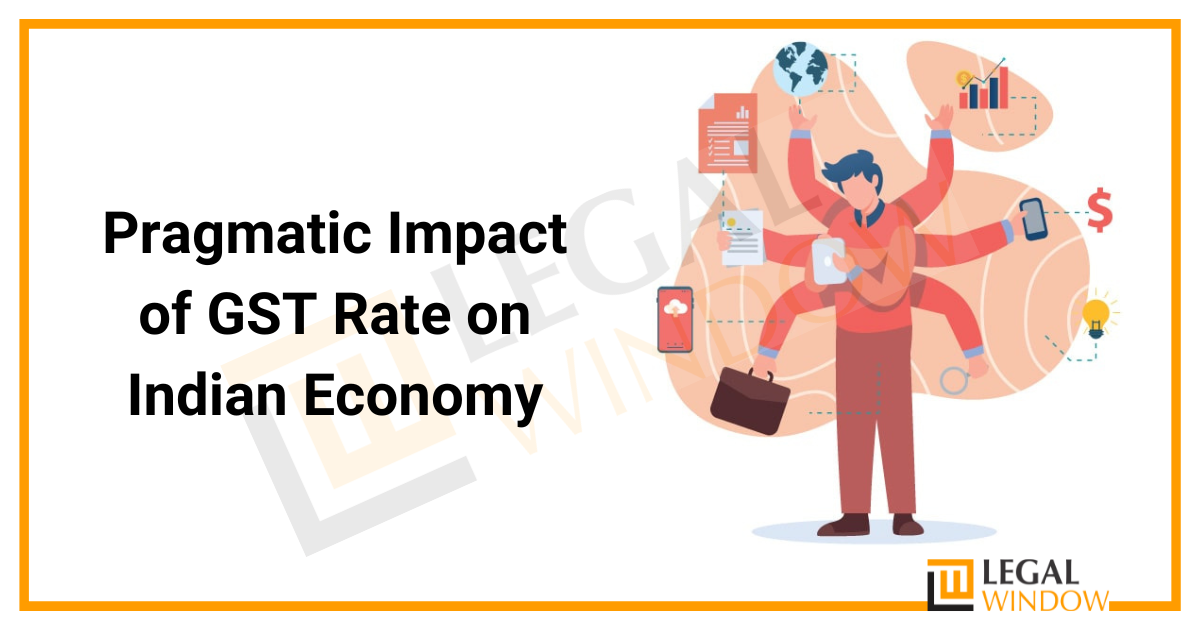
The introduction of the Goods and Services Tax (GST) in India in July 2017 marked a significant milestone in the country’s economic landscape. GST replaced a complex web of multiple indirect taxes levied by the central and state governments, streamlining the taxation system and unifying the Indian market. One crucial aspect of GST implementation is determining the tax rates applicable to various goods and services. The GST rate structure has had a pragmatic impact on the Indian economy, influencing consumption patterns, business operations, and government revenues. In this article we will discuss about Impact of GST Rate on Indian Economy.
| Table of Content |
What is GST?
GST is a value-added tax levied on the supply of goods and services. It is an indirect tax that is borne by the final consumer but collected and remitted to the government by the businesses involved in the supply chain. The concept of GST is based on the principle of taxing the value addition at each stage of the supply chain. By doing so, it avoids the cascading effect of taxes, where taxes are imposed on taxes, and ensures that only the final consumer bears the tax burden.
The introduction of GST brings numerous advantages. Firstly, it simplifies the tax structure by replacing multiple taxes like central excise duty, service tax, value-added tax (VAT), and others. It also helps in eliminating the multiplicity of tax rates and brings uniformity in the tax system. Additionally, GST facilitates seamless credit utilization, allowing businesses to claim input tax credits on their purchases and offsetting them against the tax liability on their supplies. This reduces the tax burden and improves compliance.
Types of GST prevailing in India
The following are the types of GST prevailing in India:
- Central Goods and Services Tax (CGST): CGST is the component of GST that is levied by the central government on intra-state supplies of goods and services. It is collected by the Central Board of Indirect Taxes and Customs (CBIC). The revenue collected under CGST goes to the central government.
- State Goods and Services Tax (SGST): SGST is the component of GST that is levied by the state government on intra-state supplies of goods and services. It is collected by the respective state’s tax authorities. The revenue collected under SGST goes to the state government.
Both CGST and SGST are levied on the same transaction, i.e., the supply of goods or services within a state. The rates for CGST and SGST are usually the same and are determined by the GST Council, which comprises representatives from the central and state governments. - Integrated Goods and Services Tax (IGST): IGST is the component of GST that is levied on inter-state supplies of goods and services, as well as on imports and exports. It is collected by the central government but is later apportioned between the central and state governments. The purpose of IGST is to maintain the seamless flow of goods and services between states and ensure that the tax revenue is appropriately distributed.
When goods or services are supplied from one state to another, IGST is levied at the rate determined by the GST Council. The revenue collected under IGST is shared between the central and state governments based on a pre-defined formula. - Union Territory Goods and Services Tax (UTGST): UTGST is the component of GST that is levied on the supplies of goods and services in the union territories of India. It is similar to SGST and is collected by the respective union territory’s tax authorities. The revenue collected under UTGST goes to the union territory’s government.
UTGST applies to intra-union territory supplies of goods and services and is governed by rules and regulations similar to SGST.
In addition to these types of GST, there are certain special categories such as the Compensation Cess, which is levied on specific goods and services to compensate states for any revenue loss incurred during the transition to GST.
Pragmatic impact of GST Rate on Indian Economy
GST replaced a complex web of multiple indirect taxes levied by the central and state governments, streamlining the taxation system and unifying the Indian market. One crucial aspect of GST implementation is determining the tax rates applicable to various goods and services. The GST rate structure has had a pragmatic impact on the Indian economy, influencing consumption patterns, business operations, and government revenues.
The GST rate structure in India is based on a multi-tiered system, with different rates ranging from 0% to 28%. The rates are determined based on the essentiality of goods and services, potential impact on inflation, and revenue requirements. The objective is to strike a balance between maintaining revenue neutrality and preventing any significant disruption to the market.
One of the primary impacts of GST rates on the Indian economy is its influence on consumption patterns. The tax rates on different goods and services directly affect their affordability, thereby influencing consumer behavior. Essential goods and services with lower tax rates, such as food items and basic healthcare services, become more accessible to the common man.
On the other hand, goods and services with higher tax rates, such as luxury items and certain services, become relatively more expensive, leading to reduced demand. This shift in consumer preferences can drive market dynamics, impacting sectors differently.
The GST rate structure also plays a crucial role in promoting ease of doing business and fostering economic growth. By simplifying the tax system and reducing compliance burdens, GST has made it easier for businesses to operate across state borders. However, the GST rates levied on different sectors can impact their competitiveness and profitability.
For instance, industries with higher tax rates may face challenges in pricing their products competitively, especially in comparison to sectors with lower rates. Therefore, a balanced rate structure that promotes equitable growth across industries is vital for fostering a conducive business environment.
Government revenue is another significant aspect affected by the GST rate structure. The rates chosen by the government directly impact tax collections and overall fiscal health. Lower rates may lead to increased compliance and higher tax revenues as businesses find it more beneficial to operate within the formal economy.
Conversely, higher rates can deter compliance and give rise to tax evasion, impacting government revenues. Striking the right balance between revenue generation and ensuring a simplified tax regime remains a constant challenge for policymakers.
The pragmatic impact of GST rates on the Indian economy extends beyond these immediate considerations. It also affects sectors such real estate, e-commerce, and exports, among others. For example, the real estate sector witnessed a significant impact due to the introduction of GST, primarily due to the change in tax rates.
Similarly, e-commerce players had to adapt their business models to comply with GST regulations and account for the applicable rates on different products. The impact on exports can be seen in the form of tax refunds and input tax credits that businesses can avail themselves of to maintain competitiveness in the global market.
It is crucial for the government to periodically review and fine-tune the GST rate structure to address any challenges and ensure its optimal impact on the economy. Such reviews can help identify sectors that need support or corrective measures to encourage growth.
Additionally, ensuring the stability and predictability of the rate structure helps businesses plan their operations effectively and make long-term investments confidently.
GST’s Positive Impact on the Indian Economy
It is important to note that in India, GST is levied at the point of sale of goods and services; thus, GST is levied on the taxpayer when the products or services are consumed. GST is classified into three types:
The following are the beneficial effects of GST on the Indian economy:
- GST provides India with a simple tax structure due to the single tax and easier calculation of the same. After paying for the product, the buyer has a clear notion of how much tax he has paid.
- It should be mentioned that the amount of GST to be paid is determined by the firm’s annual revenue and size. This has been a boon for small and medium-sized businesses.
- GST has been successful in lowering total taxable income, which has resulted in greater funds for production.
- There has been an increase in operations across India as a result of the single unified tax system, which makes commodities movement across India easier.
- The reduction in customs duty on goods has permitted an increase in export volume. Following the implementation of GST, manufacturing units have also been saving money while making items.
GST’s Negative Impact on the Indian Economy
The following are the negative effects of GST on the Indian economy:
- Negative impact on the Average Man: Because GST is an indirect tax, it is collected by raising the selling price. This has a detrimental influence on the common man since it affects the middle and lower-middle classes.
- Negative market impact of GST: In general, enterprises continue to struggle with input tax credit schemes, making it difficult to handle working capital requirements effectively. This is what caused GST to have a negative market impact.
- The negative impact of GST on Unemployment: Following the adoption of GST (July-2017), the unemployment rate in India increased from 3.39 to 6.06% between July 2017 and February 2018. With the ease of starting a business, self-employment is on the rise, but only for those who can afford it.
What Does the Future Hold on GST Pragmatic Rates?
In terms of long-term benefits, it is envisaged that GST will not only result in reduced tax rates, but also in lower tax slabs. Countries where the Goods and Services Tax has aided in economic transformation use only two or three rates: the mean rate, a lower rate for essential commodities, and a higher tax rate for luxurious commodities.
In India, we currently have 5 slabs with up to 3 rates – an integrated rate, a central rate, and a state rate. Cess is also charged in addition to these taxes. Fear of losing money has inhibited the government from experimenting with fewer or cheaper rates. This is unlikely to change anytime soon, while the government has stated that rates may be reconsidered once the RNR (revenue neutral rate) is reached.
In the medium run, the impact of GST on macroeconomic indicators is expected to be quite good. The cascading (tax on tax) impact of taxes would be abolished, lowering inflation.
The government’s tax collection is extremely likely to increase with an expanded tax net, while the fiscal deficit is predicted to remain under control. Furthermore, exports would expand, as would FDI (Foreign Direct Investment). Industry experts believe that the execution of the most significant tax reform in the country’s history will propel the country up many rungs in terms of ease of doing business.
Impact of GST Rate on other sectors in Indian Economy
The impact of GST Rates on various other sectors are as follows:
- Simplification and Transparency: The introduction of the GST has simplified the tax structure in India by subsuming various indirect taxes into a single comprehensive tax. The GST rate structure is designed to be transparent, with clearly defined tax slabs. This simplification and transparency have reduced tax evasion, increased compliance, and improved overall tax collection efficiency. The pragmatic impact of this streamlined tax structure is a boost to the formal economy and increased revenue for the government.
- Boost to Manufacturing and Export: One of the key objectives of GST implementation was to promote the manufacturing sector and enhance export competitiveness. The GST rates on raw materials, intermediate goods, and final products play a crucial role in determining the cost of production and, consequently, the competitiveness of Indian products in the global market.
By providing input tax credit and reducing the cascading effect of taxes, GST has made Indian manufacturing more cost-effective and globally competitive. The pragmatic impact of favorable GST rates on manufacturing and exports is evident in the increased production, job creation, and foreign exchange earnings for the country. - Consumer Spending and Inflation: GST rates directly affect consumer spending and, consequently, the rate of inflation. The tax rates on goods and services impact their final prices, which can influence consumer behavior and overall demand. Lower GST rates on essential commodities and services ensure affordability for the masses, thus positively impacting consumption patterns. On the other hand, higher GST rates on luxury items discourage excessive consumption and promote responsible spending. By aligning tax rates with consumption patterns, the pragmatic impact of GST on consumer spending is a more balanced and sustainable economy.
- Sector-Specific Implications: Different sectors of the Indian economy have varying GST rate structures, which have sector-specific implications. For example, sectors such as real estate, automobiles, and construction have seen significant changes in their tax rates and input tax credit availability. The pragmatic impact of sector-specific GST rates varies.
While some sectors have witnessed a boost in demand and growth due to reduced tax burdens, others have faced short-term challenges in adapting to the new tax regime. Overall, sector-specific GST rates aim to promote equity and ensure a fair tax burden across industries. - Revenue Generation and Fiscal Consolidation: GST rates directly impact the revenue generation capacity of the government. The tax rates must strike a balance between generating sufficient revenue for the government and avoiding excessive tax burden on businesses and consumers. By broadening the tax base, improving compliance, and reducing tax evasion, GST has increased revenue collection for the government.
This additional revenue contributes to fiscal consolidation, enabling the government to invest in infrastructure development, social welfare programs, and other priority areas. The pragmatic impact of well-calibrated GST rates is a stronger fiscal position for the country.
Takeaway
In conclusion, the pragmatic impact of GST rates on the Indian economy is far-reaching. It influences consumption patterns, business operations, and government revenues. The GST rate structure plays a vital role in shaping market dynamics, promoting ease of doing business, and driving economic growth. It is essential for the government to strike a balance between revenue generation and maintaining a simplified tax regime. By continually assessing and fine-tuning the rates, policymakers can ensure that GST continues to contribute positively to India’s economic progress.
Our Experts can assist you in explaining you the impact of GST Rates on Indian Economy. You can connect with our Experts on Legal Window.
CA Pulkit Goyal, is a fellow member of the Institute of Chartered Accountants of India (ICAI) having 10 years of experience in the profession of Chartered Accountancy and thorough understanding of the corporate as well as non-corporate entities taxation system. His core area of practice is foreign company taxation which has given him an edge in analytical thinking & executing assignments with a unique perspective. He has worked as a consultant with professionally managed corporates. He has experience of writing in different areas and keep at pace with the latest changes and analyze the different implications of various provisions of the act.
Categories
- Agreement Drafting (23)
- Annual Compliance (11)
- Change in Business (36)
- Company Law (148)
- Compliance (90)
- Digital Banking (3)
- Drug License (3)
- FEMA (17)
- Finance Company (42)
- Foreign Taxation (6)
- FSSAI License/Registration (14)
- GST (120)
- Hallmark Registration (1)
- Income Tax (202)
- Latest News (34)
- Miscellaneous (165)
- NBFC Registration (8)
- NGO (14)
- SEBI Registration (6)
- Section 8 Company (7)
- Start and manage a business (21)
- Startup/ Registration (130)
- Trademark Registration/IPR (40)
Recent Posts
About us
LegalWindow.in is a professional technology driven platform of multidisciplined experts like CA/CS/Lawyers spanning with an aim to provide concrete solution to individuals, start-ups and other business organisation by maximising their growth at an affordable cost.









